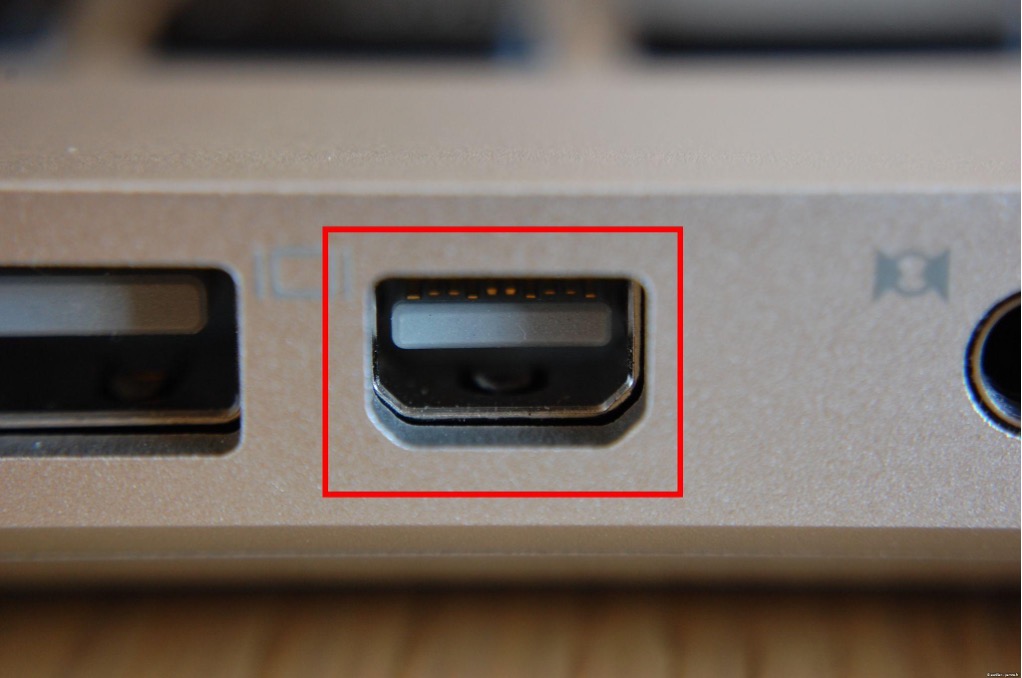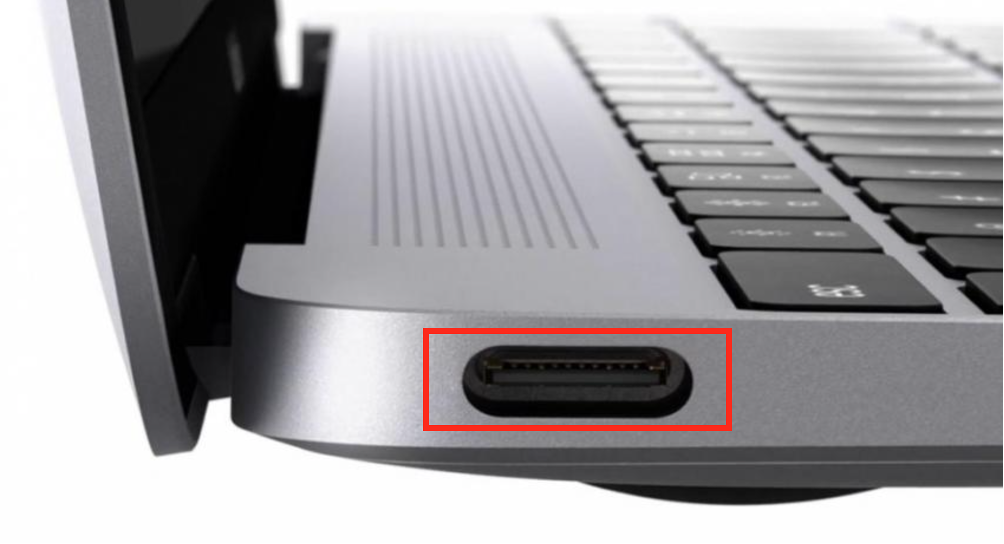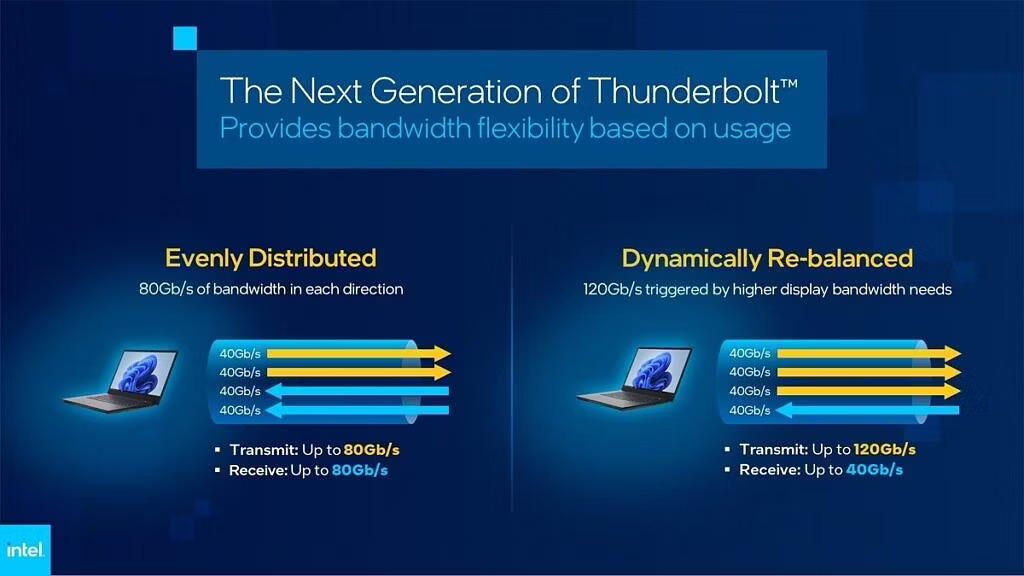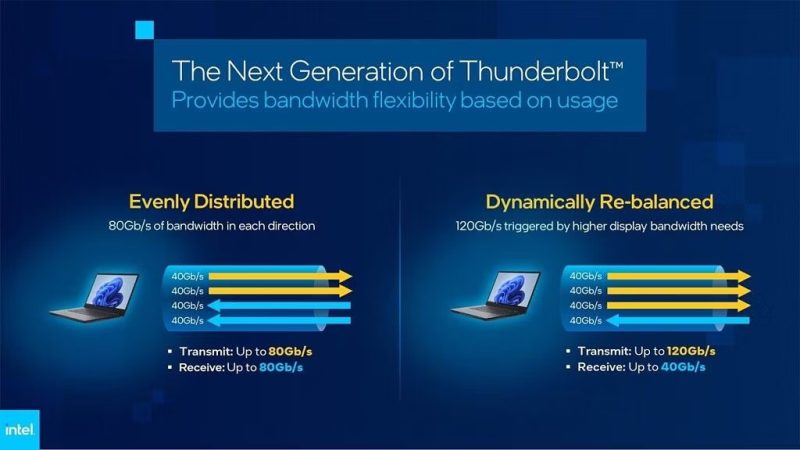Since its debut in July 2020, Intel’s Thunderbolt 4 has been the gold standard for high-speed data transfer and charging. Built on the foundation of its predecessor, Thunderbolt 3, Thunderbolt 4 offered much more improved features, such as enhanced data transfer speed, 100W power delivery, support for multiple 4K displays, etc.
However, things are getting even crazier with the recent announcement from Intel about their new Thunderbolt technology (Thunderbolt 5) that is slated to take over from Thunderbolt 4 as the next-generation connectivity standard.
Table of Contents
What is Thunderbolt?
Before we look at Thunderbolt 5 specifications and release date, we should have a refresher on the different connection types we have today and, more specifically, understand the Thunderbolt technology.
The Thunderbolt hardware interface was first released on February 24, 2011, as Thunderbolt 1. It offered high-speed data transfer and power delivery over a single cable, making it a more versatile and convenient option than other connectors. Thunderbolt 2 was later introduced in 2013 and came with more capabilities than its predecessor. Both Thunderbolt 1 and 2 used a Mini DisplayPort-shaped connector.

Later, Thunderbolt 3 and Thunderbolt 4 interfaces were introduced, and these two (especially the latter) revolutionized the tech industry. Thunderbolt 4 introduced several additional features, including improved data transfer speeds, the ability to deliver up to 100 watts of power, support for multiple 4K displays, and more. Unlike Thunderbolt 1 and 2, Thunderbolt 3 and 4 used the USB-C connector.

What’s new in Thunderbolt 5?
Recently, Intel gave us a sneak peek at its new Thunderbolt technology, intended to surpass Thunderbolt 4. This upcoming Thunderbolt technology does not carry the official name “Thunderbolt 5” but is referred to by the nickname “next-gen.” However, the Thunderbolt naming technology is quite predictable, and there is no way Intel would call this massive leap in technology “Thunderbolt 4.1.”
Key Features and Improvements
While Intel has not officially released the features we should expect, we all know that every new Thunderbolt technology strives to push the boundaries of data transfer, power delivery, and device connectivity.
Below are some of the key features and improvements you should expect
1. 80Gbps bi-directional bandwidth (or up to 120Gbps uni-directional)
The support for 80Gbps bi-directional bandwidth (or up to 120Gbps uni-directional) is one of the critical features of Thunderbolt 5. In simple terms, Thunderbolt 5 can transfer data at speeds of up to 80Gbps in both directions or 120Gbps in one direction. That is twice the bandwidth of Thunderbolt 4 and four times that of Thunderbolt 3.
But how likely is that? You see, similar to its predecessors, Thunderbolt 5 supports four data lanes for data transfer. When transmitting data in both directions, each data lane will handle data at 40 Gbps, with two data lanes receiving data while the other two transmitting data.
In a uni-directional transfer, the data lanes are dynamically rearranged in a way that three data lanes are transmitting data at a speed of 40Gbps each (which makes that 120Gbps), and there is only one data lane that is receiving data at a speed of 40Gbps.
Have a look at the image below.

The 80gbps bi-directional bandwidth support means that Thunderbolt 5 can transfer data at high speed to and from a device. That is an excellent feature for tasks like transferring files, backing up data, and connecting to external storage devices.
The 120Gbps for uni-directional data transfer means Thunderbolt 5 can transmit data at high speed in one direction. This feature will come in handy when you need to transfer data at high speed in one direction. For example, when connecting an external GPU or a high-resolution display.
2. Support for DisplayPort 2.1, which can drive up to two 8K displays or four 4K displays at 60Hz
When Thunderbolt 4 came out, it was based on USB4, which used an older standard called DisplayPort 1.4. This meant that even if you connected it to a fancy monitor or device that used DisplayPort 2.1, it couldn’t show off its full capabilities – it was like having a fast car on a slow road.
Now, with Thunderbolt 5, things are different. Thunderbolt 5 plays nice with the latest DisplayPort 2.1 standard, so it can make the most out of all the cool features it offers. Some of these features include:
- Higher resolutions (Sharper Pictures): You can enjoy super high resolutions – up to 10K at 60 times per second (Hz) or 8K at 120Hz. That’s like having a super-clear view on your screen.
- Higher refresh rates: If you’re into gaming or want everything to look smooth, DisplayPort 2.1 supports refresh rates up to 240Hz.
- More Data Speed (bandwidth): It also brings loads of data power, offering up to 80 gigabits per second (Gbps) bandwidth. That’s twice as fast as the older DisplayPort 1.4, so you can transfer data even quicker.
The fact that Thunderbolt 5 supports DisplayPort 2.0 is excellent news. It means you can link up two super sharp 8K screens or four clear 4K screens running smoothly at 60 times per second. This is useful for users like artists, gamers, and anyone wanting to connect to many fancy, high-quality screens.
3. Power delivery up to 100W
One of the standout features of the Thunderbolt 5 is its impressive power delivery capabilities. It can deliver a whopping 100 watts of power to your connected devices, such as laptops or tablets. To put it in perspective, that’s twice the power of the Thunderbolt 4 and more than four times that of the Thunderbolt 3.
This feature presents significant improvements over the last Thunderbolt versions. These include:
- Faster device charging: The 100W power supply will enable Thunderbolt 5 to charge laptops, tablets, external GPUs, and other high-powered devices far faster than in the past This will reduce the time it takes to charge your device and make them ready to be used.
- Single-Cable Solutions: Thunderbolt 5’s high power delivery would make it possible to use a single Thunderbolt 5 cable for both data transfer and charging. This simplifies cable management and reduces the number of cables cluttering your workspace.
- Versatile Docking: Users could connect their laptops to Thunderbolt 5 docks, which provide power, data connectivity, and support for external displays through a single cable. This would create a convenient and efficient workstation setup.
4. PAM-3 signaling technology
Thunderbolt 5 uses a new signaling technology called PAM-3 (Pulse Amplitude modulation-3) to deliver significant increases in performance with today’s printed circuit boards, connectors, and passive cables up to 1 meter.
PAM-3 is a data transmission technique that uses three different voltage levels to represent each bit of data. That allows Thunderbolt 5 to transmit more data per clock cycle than Thunderbolt 4, which uses PAM-2 (Pulse Amplitude modulation-2), which only uses two voltage levels.
PAM-3 signaling is also more robust to noise and interference than PAM-2 signaling. This means that Thunderbolt 5 can achieve higher speeds and reliability over existing cables and connectors.
5. Support for PCIe 4.0, which can provide up to 32Gbps of bandwidth for external devices
The support for PCIe 4.0 is another critical feature of Thunderbolt 5. PCIe 4.0 is the modern-day PCIe standard model, offering several upgrades over previous variations. This includes:
- Higher bandwidth: PCIe 4.0 offers as much as 32Gbps of bandwidth, which is twice the bandwidth of PCIe 3.0.
- Lower latency: PCIe 4.0 has lower latency than PCIe 3.0, so information can be transferred quickly.
- More lanes: PCIe 4.0 comes with more data lanes than PCIe 3.0. That means users can now connect more devices than before.
The support for PCIe 4.0 in Thunderbolt 5 means that customers can connect external devices that require high bandwidth, such as external GPUs and excessive-speed storage gadgets. For instance, an external GPU with a PCIe 4.0 connection can offer as much as two times the overall performance of an external GPU with a PCIe 3.0 connection. This makes Thunderbolt 5 a treasured answer for gamers and customers who need high-performance graphics.
Thunderbolt 5’s support for PCIe 4.0 isn’t just great for external GPUs but also for speedy storage devices like NVMe SSDs. These SSDs can transfer data around at up to 3.5GB/s. With Thunderbolt 5’s PCIe 4.0 support, you can tap into all that blazing-fast speed for your storage needs.
6. Backward compatibility with Thunderbolt 4 and USB4 devices
Thunderbolt 5 plays nice with older Thunderbolt 4 and USB4 gadgets. This means you can plug your Thunderbolt 5 stuff into Thunderbolt 4 or USB4 ports and vice versa.
How is that possible?
Thunderbolt 4, Thunderbolt 3, and USB4 all use the same USB-C connector and cable standard, meaning they can talk to each other. When you connect a Thunderbolt 5 gadget to a Thunderbolt 4 or USB4 port, they’ll chat and figure out the fastest speed they can handle. For example, if you plug a Thunderbolt 5 device into a Thunderbolt 4 port, they’ll agree to go at Thunderbolt 4 speed, which is 40Gbps.
This backward compatibility is super handy. You can keep using your older Thunderbolt 4 and USB4 stuff with Thunderbolt 5, and when you upgrade to Thunderbolt 5 devices, you don’t have to toss out your old gear.
When is Thunderbolt 5 coming?
Intel isn’t spilling the beans when we can expect Thunderbolt 5 to arrive. Right now, we just have a sneak peek, and some are talking about his speed. As for the official launch date, it remains a mystery.
Intel has just released its 13th-gen processor for our computers, but Thunderbolt 5 hasn’t come along for the wagon. Maybe we should hold the horses and wait for the next Intel processors, which should show up by the end of the year. Only then will we have a good idea of when Thunderbolt 5 will arrive.





